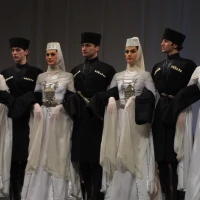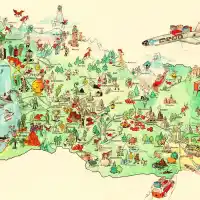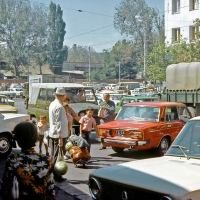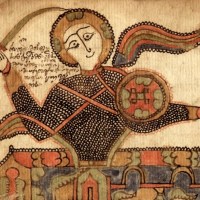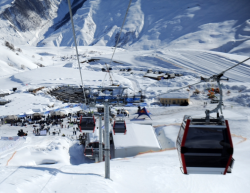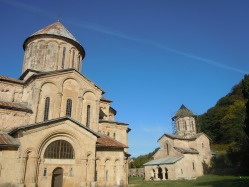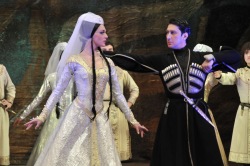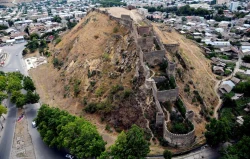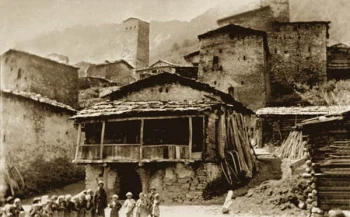About Sights – Davit Gareja
Founded in the 6th century by St. David Garejeli, Davit Gareja (Georgian: დავითგარეჯის სამონასტრო კომპლექსი) is a Georgian Orthodox monastery complex located on the slopes of Mount Gareja in the Kakheti region of eastern Georgia. The complex includes hundreds of cells, churches, chapels, refectories and living quarters hollowed out of the rock. Part of the … Continue reading
About Sights – Martvili Monastery
Martvili Monastery (Georgian: მარტვილის მონასტერი) is a monastic complex located in the village of Martvili in Samegrelo-Zemo Svaneti region. The hill on which it stands was a former pagan site associated with fertility and prosperity. The Martvili-Chkondidi Cathedral was constructed in the late 7th century on top of the roots of an enormous oak tree … Continue reading
About Sights – Tbilisi Sioni Cathedral
The Sioni Cathedral of the Dormition (Georgian: სიონის ღვთისმშობლის მიძინების ტაძარი) in Tbilisi was originally built in the 6th and 7th centuries but was subsequently destroyed by foreign invaders and reconstructed several times. The current church is based on a 13th-century version. Named after Mount Zion at Jerusalem, it is commonly known as the “Tbilisi … Continue reading
About Events – Khelaoba
“Khelaoba” is held annually in Chargali village in Dusheti on 25 January and commemorates the anniversary of the death of Georgian poet Mikha Khelashvili (1900 – 1925) (Georgian: მიხა ხელაშვილი). An anti-Soviet, he was shot and killed in Chargali village on his birthday. “Khelaoba” commemorates the anniversary of the death of Georgian poet Mikha Khelashvili … Continue reading
About Sights – Mutso
Mutso (Georgian: მუცო) is one of the former Khevsur strongholds of the historic Georgian province of Khevsureti (now part of Mtskheta-Mtianeti region) in north-eastern Georgia. Its medieval fortified dwellings and towers are arranged on vertical terraces above the Mutso-Ardoti gorge. Recent restoration work by the National Agency for Cultural Heritage Preservation will help to preserve … Continue reading
About Events – Krtsanisoba
The day of 300 heroes – “krtsanisoba” is celebrated annually in Tbilisi on September 24. The Three Hundred Aragvians (Georgian: სამასი არაგველი) from the Aragvi valley fought a last stand at the battle of Krtsanisi, defending Tbilisi against the invading Qajar army in 1795. A monument to the 300 Aragvians, created by A. Bakradze, was … Continue reading
About History – Photographs of Tbilisi in 1976
In 1976, the Georgian Soviet Socialist Republic was part of the USSR. During the Soviet rule, the country’s capital, Tbilisi, became more industrialised and its population grew significantly. The following black and white photographs, taken in Tbilisi in 1976, reveal glimpses of city life during Soviet times. Photo source: Tbilisi Week CLICK on the logo to visit GEORGIA … Continue reading
About Celebrations – Independence Day 2015
Georgia celebrates Independence Day (Georgian: დამოუკიდებლობის დღე) on 26 May each year. On 26 May 1918, in the midst of the Russian Civil War, Georgia declared independence and The Democratic Republic of Georgia was created. The day is a national holiday and celebrations are held throughout Georgia and by Georgians living overseas. In the nation’s … Continue reading
About Celebrations – Victory Day in Tbilisi
Victory Day was commemorated in Georgia on 9 May. 2015 marks the 70th anniversary (Georgian: ფაშიზმზე გამარჯვების 70-ე წლისთავი) of the formal surrender of Nazi Germany to the Soviet Union in Berlin in May 1945. Georgian veterans and their families gathered at the Tomb of the Unknown Soldier in Vake Park in Tbilisi to honor those … Continue reading
About Sights – Bethlemi Hut
Located at a height of 3,653 m on Mount Kazbegi (Georgian: ყაზბეგის მყინვარწვერი), Bethlemi Hut is the highest located building in Georgia. Originally constructed of wood in 1933, it was designed as a shelter for climbers. In 1941, a stone building replaced the wooden one and served as a climber’s shelter and meteorological station. Annually, … Continue reading
About Sights – Ilia Chavchavadze Monument in Batumi
Ilia Chavchavadze is widely regarded as one of the founding fathers of modern Georgia. Revered as Pater Patriae (Father of the Fatherland) of Georgia, he spearheaded the revival of the Georgian national movement in the second half of the 19th century. A monument to Chavchavadze was erected in the city of Batumi on Georgia’s Black Sea coast … Continue reading
About History – The First Printed Book in Georgian
The first printed book in Georgian was published in Rome in 1629 by Niceforo Irbachi (Nicholas Irubakidze-Cholokashvili) (Georgian: ნიკოლოზ ჩოლოყაშვილი; ნიკოლოზ ირუბაქიძე-ჩოლოყაშვილი), a Georgian Orthodox priest, politician and diplomat. The book was a Georgian Alphabet with prayers, which was later accompanied with a Georgian – Italian dictionary. CLICK on the logo to visit GEORGIA ABOUT on Facebook and see photos … Continue reading
About Events – The 1984 Voyage of the Replica “Argo”
British explorer, historian and writer Tim Severin commissioned a replica of the Greek mythological galley “Argo” and in 1984 retraced the voyage of Jason and the Argonauts. Severin and his crew rowed and sailed from northern Greece, through the Dardanelles, across the Marmara Sea, and through the Straits of Bosphorus to the Black Sea coast … Continue reading
About Sights – Poti Lighthouse
The lighthouse in the port city of Poti (Georgian: ფოთი) in Georgia’s Samegrelo-Zemo Svaneti region is one of the oldest navigation facilities on the coast of the Black Sea. Made of cast iron, it was constructed in England and transported by steamship to Georgia in 1864. Ships approach Poti harbor from the north, parallel to … Continue reading
About Famous Georgians – Kola Kwariani
Born in the city of Kutaisi in Georgia on 16 January 1903, Kola Kwariani (Georgian: კოლა (კოლია) ქვარიანი) was a Georgian professional wrestler known by the ring name Nicholas Kwariani or Nick the Wrestler. Kola saw wrestling for the first time at the age of 7 at a circus performance in Kutaisi and in 1917 … Continue reading
About Events – The Hundred Thousand Martyrs of Tbilisi
The Georgian Orthodox Church commemorates the Hundred Thousand Martyrs (Georgian: ასი ათასი მოწამე) on 13 November each year. The Martyrs were put to death by Sultan Jalal al-Din of Khwarazm for not renouncing Christianity following his capture of the Georgian capital of Tbilisi in 1226. The Metekhi Bridge is traditionally considered to have been the … Continue reading





























































